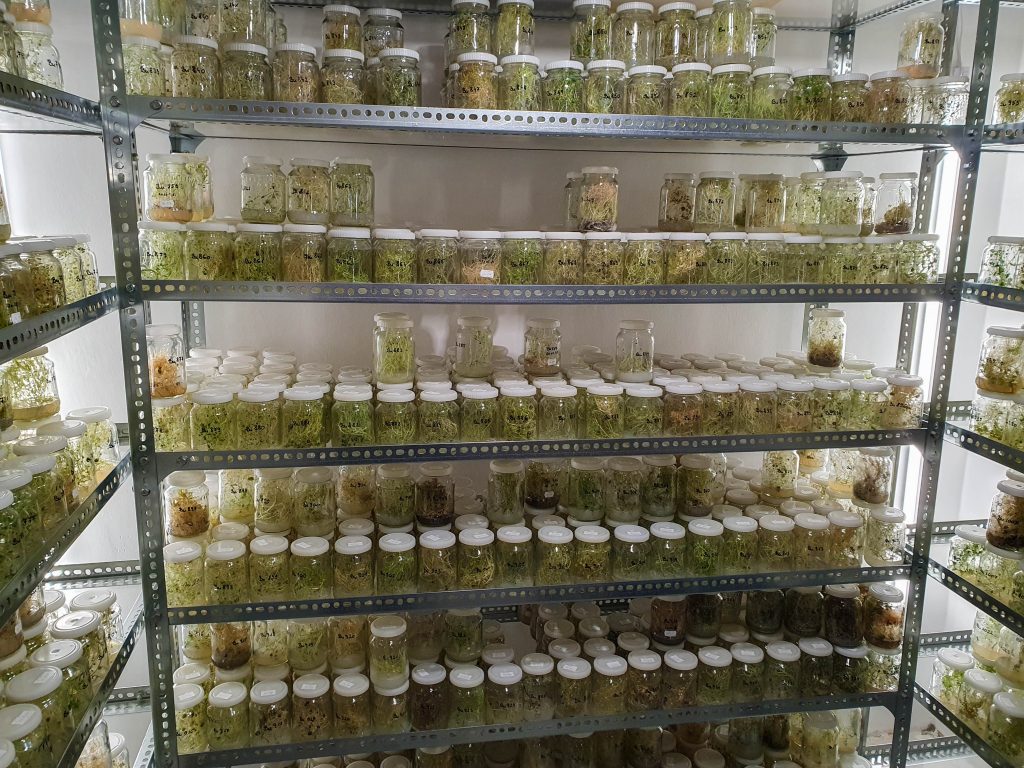A post by Samuel Gogniat, Lioba Lieb, Veronika Schlosser and Wenzel Steinhilper

The genetic resources of and within crop species and their wild relatives form the basis of our food production system [1]. They allow varieties to evolve and adapt to changing conditions and are valuable for further breeding programs. However, the genetic diversity of plants is currently decreasing. Hence, it is important to preserve as much of our genetic heritage as possible. During our summer school on agrobiodiversity in Hungary, we had the opportunity to visit the country’s largest genebank, the National Centre for Biodiversity and Gene Conservation (NBGK) in Tápiószele.
The NBGK conserves over 56’000 unique accessions (see Table 1) [2]. These are mostly sustained in ex situ conservation, which is the conservation of biological diversity outside its natural habitat [3].
Table 1: Detailed information on accessions per plant group [2].
| Conservation method | Plant group | N° of unique accessions |
| Seedbank | Cereals | 20’866 |
| Grain legumes | 10’386 | |
| Vegetables | 10’638 | |
| Others (Industrial crops, forage legumes, grasses) | 9’938 | |
| Wild species | 1’897 | |
| Vegetative preservation | Tuber crops | 47 |
| Onions | 197 | |
| In vitro collection | Potato | 583 |
| Plantation | Ornamental plants, Woody plants, grapes | 1694 |
| In total | 56’201 |
Genebanks generally operate according to standards set by the Food and Agriculture Organization (FAO). A new accession enters the genebank either through a collection mission or through an exchange with other genebanks. Before the seed (accession) can be stored, the accession is given an identifier, propagated, dried and tested for viability. Further, there are two different ways of storage, depending on the duration and purpose. Within the active collection, seeds are stored at 5-10 °C, which allows a further use of the genetic material e.g., for propagation. In addition, there is the base collection, where seeds are stored at -20°C for the long term (up to 100 years).
Despite the important work that large genebanks do, there is also criticism. They are centralized within a country and not really part of the local community [4]. As a result, the control of the resources is held by the state and not the farmers themselves. Therefore, community seedbanks have been introduced. These directly address the needs of local farmers. Their main aim is to increase the resilience of the food system by providing local seed varieties directly to the farmers, thereby strengthening local collaborations.
It’s worth mentioning that the NBGK also works with farmers. They provide more than 400 varieties that local farmers and home growers can access. The conservation center also hosts and organizes an on-farm network, which was relaunched in 2018 and consists of 20 farms. Farmers in the network receive seeds of local varieties, which they then describe in a questionnaire after cultivation. NBGK´s on-farm project has several objectives. First, it collects information about the varieties. Second, it complements the genebanks ex situ conservation with in situ (or on-farm) conservation, which has been strongly promoted in recent centuries [1]. This is important for the survival of a species in its natural habitat and allows it to adapt to a changing environment [5]. Another benefit of the on-farm network is that if accessions are lost, they can be recovered from farmers. Finally, demonstration gardens and tours have been developed, playing an important role in raising public awareness and disseminating genetic resources.
During our visit in September 2023, we were able to observe all the steps involved in preserving genetic diversity. We observed germination tests, “froze” in the storage rooms and were amazed to see 700 different varieties of potatoes being propagated. When blogging about our visit, we thought it is worth mentioning that you could even order seeds from the NBGK to Switzerland. So, if anyone is interested in growing Hungarian rye varieties in their gardens, check out their website. 😉
This blog post was written as part of the “Agrobiodiversity Summer School” in Hungary in September 2023. This summer school is a cooperation project between the ZHAW Institute of Natural Resource Sciences, the Research Institute of Organic Agriculture in Switzerland (FiBL) and Hungary (ÖMKi) and is supported by the Mercator Foundation Switzerland.
[1] Engels, J. M. M., & Ebert, A. W. (2021). A Critical Review of the Current Global Ex Situ Conservation System for Plant Agrobiodiversity. I. History of the Development of the Global System in the Context of the Political/Legal Framework and Its Major Conservation Components. Plants, 10(8), Article 8. https://doi.org/10.3390/plants10081557
[2] NBGK. (n.d.). National Centre for Biodivertsity and Gene Conservation (NBGK). Retrieved 4 September 2023, from https://www.nbgk.hu/home/
[3] FAO. (2014). Genebank Standards for Plant Genetic Resources for Food and Agriculture. Rome, Italy. http://www.fao.org/3/i3704e/i3704e.pdf
[4] Vernooy, R., Sthapit, B. R., & Bessette, G. (2020). Community seed banks: Concept and practice. Facilitator handbook (updated version). https://cgspace.cgiar.org/handle/10568/81286
[5] Martins, C. (2015). Agrobiodiversity – the key to food security, climate adaptation and resilience. Deutsche Gesellschaft für Internationale Zusammenarbeit (GIZ) GmbH.